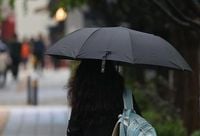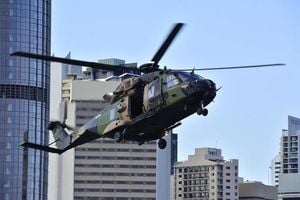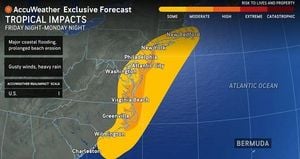As the calendar edges toward September, South Korea finds itself in the grip of a rare and punishing weather pattern—a relentless heatwave coupled with heavy, sometimes violent, summer rains. Across the country, from the bustling streets of Seoul to the southern port city of Busan, residents are contending with an exhausting blend of sweltering temperatures, tropical nights, and the threat of thunderstorms and flooding. The past few days have tested both patience and infrastructure, with meteorologists warning that the worst may not be over just yet.
According to KBS, Busan experienced particularly severe conditions on August 30, 2025, as heavy rain and thunderstorms swept through the city, drenching neighborhoods with between 20 and 80 millimeters of precipitation. The downpours, accompanied by strong winds and frequent lightning, were expected to continue into Sunday, August 31, with the southern region of Busan bearing the brunt of the storm. These conditions, KBS reported, have left residents on edge and authorities on high alert.
But Busan was hardly alone. As reported by Yonhap News TV, a cold front moving across the Korean Peninsula triggered widespread thunderstorms and heavy showers in numerous regions, particularly in the south. Rainfall amounts reached up to 60 millimeters in Suwon and between 5 and 30 millimeters in Chungcheongnam-do on August 30. The forecast predicted that these storms, bringing not just rain but also thunder, lightning, and the risk of sudden gusts, would persist into August 31, with southern and coastal areas expected to receive the most substantial rainfall.
Meanwhile, the heat simply refused to let up. Despite being on the cusp of autumn, the entire nation remained under a blanket of oppressive warmth. Temperatures soared: Seoul reached 31 degrees Celsius, Gwangju and Daejeon hit 33 degrees, and Daegu sizzled at 35 degrees. The humidity only made things feel hotter, with meteorologists warning that the combination of high heat and moisture would make the air feel stifling and uncomfortable. As Yonhap News TV’s weathercaster Kim Su-jin put it, "Even though September is just around the corner, the heatwave continues unabated." She advised, "If you’re heading out, dress coolly and don’t forget your umbrella."
The Korea Meteorological Administration (KMA) issued a series of escalating warnings as the weekend progressed. As reported by Econovill, heatwave advisories and warnings blanketed much of the country, including Gyeonggi-do, Gangwon-do, Chungcheongnam-do, Chungcheongbuk-do, Jeolla-nam-do, Gyeongsangbuk-do, Gyeongsangnam-do, and Jeju-do. The KMA cautioned that both the heat and the tropical nights—where overnight temperatures fail to drop below 25 degrees Celsius—would persist at least through the morning of August 31. In some areas, notably Seoul, Incheon, Gyeonggi, and western Chungcheongbuk-do, rain was forecasted to arrive by dawn, bringing with it the risk of thunderstorms, lightning, and strong winds.
With the rain came new hazards. The KMA warned that in Jeju-do, showers would be accompanied by thunder, lightning, and blustery winds. Elsewhere, from the central inland to the southern coasts, the possibility of dense fog in the early morning hours—especially in valleys and near bodies of water—posed a threat to drivers, reducing visibility to less than a kilometer in some spots. The risk of traffic accidents, the agency noted, was significantly elevated under such conditions.
Sunday, August 31, was expected to bring more of the same, with the weather taking on an almost biblical character. According to Gokorea, the entire country was forecasted to be overcast, with rain beginning in Jeju-do before spreading to the southern provinces in the morning and then to the capital region and central areas by afternoon. Rainfall totals were projected to be significant: between 30 and 80 millimeters in Seoul, Incheon, Gyeonggi, the Chungcheong provinces, and the interior and mountainous parts of Gangwon. In some areas, particularly eastern Jeolla-nam-do, Gyeongsangnam-do, and the mountain regions of Jeju, downpours could exceed 80 millimeters, raising the specter of flash floods and landslides.
The dual threat of heat and rain created what Gokorea described as a “double hardship” for the nation. While daytime highs hovered around 30 degrees Celsius, nighttime temperatures in major cities and coastal regions refused to dip below 25 degrees, resulting in prolonged tropical nights. This unyielding warmth, especially at night, can be more exhausting than the midday heat, increasing the risk of heat-related illness and straining the country’s power grid as air conditioners run around the clock.
Authorities urged caution, especially for those with cardiovascular or respiratory conditions. The KMA explained, "When tropical nights persist, body temperature doesn’t drop overnight, increasing the danger for those with underlying health issues." The agency also highlighted the risk of localized flooding and landslides, particularly in regions where torrential rain was forecasted. For those living near rivers, lakes, or on steep slopes, the advice was clear: remain vigilant and monitor weather updates closely.
Maritime safety also became a concern, with warnings issued for the West Sea, South Sea, and waters around Jeju. Fog, sudden gusts, thunder, and lightning were all expected to disrupt vessel operations, potentially leading to delays or hazardous conditions for fishermen and commercial shipping alike.
Despite the discomfort and danger, South Koreans have shown remarkable resilience. Many have adapted by shifting their routines—heading out early to avoid the afternoon sun, or staying indoors during the worst of the storms. Still, the strain on daily life is evident. Local governments have opened cooling centers and distributed water, while emergency crews remain on standby for flood response and rescue operations.
Looking ahead, the KMA predicted that the intense weather would linger into September. While the heatwave advisories and warnings may eventually ease, the risk of sudden, heavy rainfall remains, especially as the cold front continues its slow march across the peninsula. For now, South Korea must navigate this challenging period with caution, patience, and a watchful eye on the ever-changing skies above.
The convergence of heat and rain has made the end of summer 2025 one to remember for all the wrong reasons. As the nation waits for relief, the hope is that cooler, calmer days are finally on the horizon—and that the lessons learned from this bout of extreme weather will help communities better prepare for whatever comes next.
![“8월 마지막 날까지 찜통 더위” … 열대야 · 폭염경보, 새벽 소나기 예보 [날씨]](https://thumbor.evrimagaci.org/MuH-6WfhjR0pkJnKjNdeBHiVBKw=/200x0/tpg%2Fsources%2F51777e91-1871-4664-9cfa-afcc70a3074b.jpeg)




